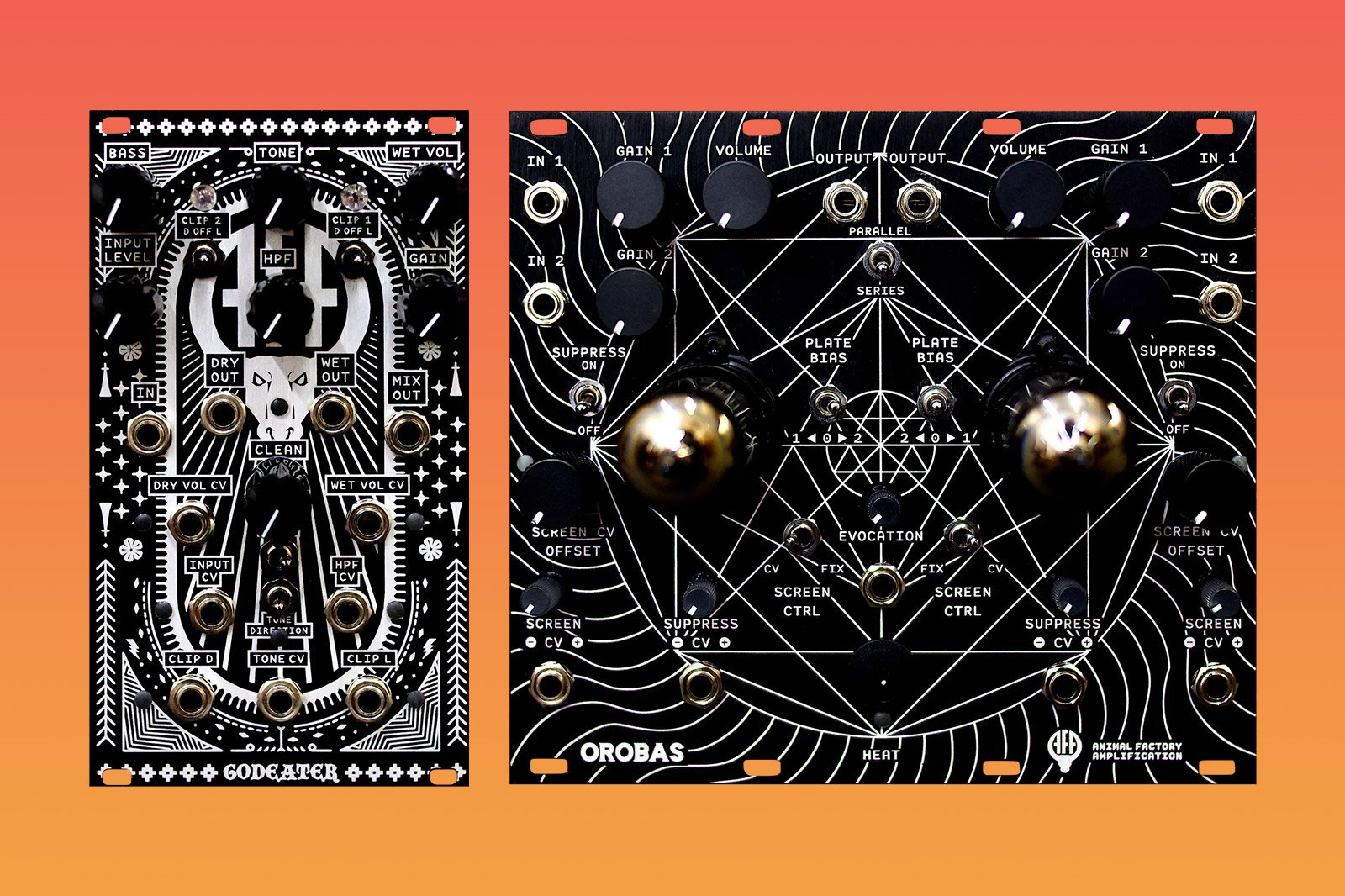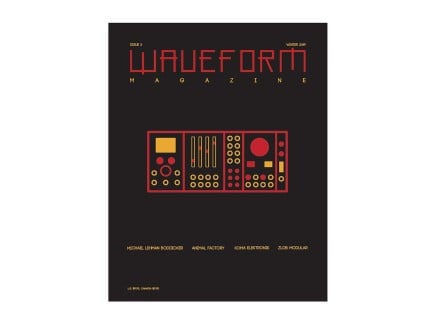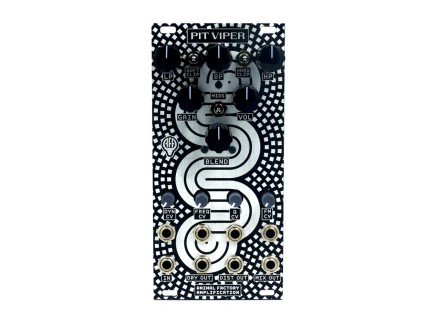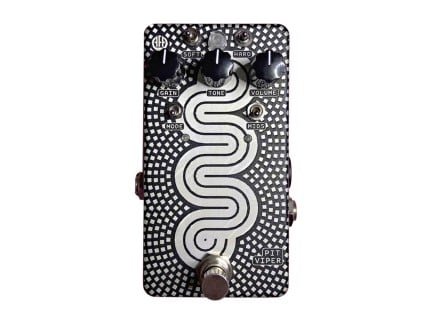The world can be a ruthless place. Life can be hard. This is a universal truth and no more of an explanation is needed for why every year millions of people from around the world travel far from their homes with an idea, a hope, that some place, some piece of land with perceived healing powers of spiritual enlightenment, or overall transcendence will somehow transform their lives for the better, to right what has been wronged, be put on a better path, to bring serenity to an otherwise un-serene lifestyle. India is one such place, but nothing is ever this simple. The universe has a way of balancing things, and where there is light there is dark. Where there is peace [Where? Where is there peace?] there is war. Where there is serenity and enlightenment there is anger and rage.
Animal Factory is Aditya Nandwana, a destroyer of sound, a believer in sonic destruction. Growing up in Bombay, but having studied in Germany, Nandwana’s path to channeling his aggressive and rebellious tendencies through Animal Factory’s guitar pedals and Eurorack modules has been unconventional. A self professed “bad musician,” it was this lack of musicianship that spurred him to seek out a distinct sound, to hunt for abstract and harsh tones, to separate himself from the crowd. But how do you stand out in the crowd of a country that’s surpassed a billion people? How do you make your voice heard? Through extremes. Peace, love, enlightenment: Anger, destruction, rage.
The world can be ruthless, and peace has its place, but...bring on the rage.
Interview: Animal Factory's Background

Ellison Wolf: Animal Factory is known for its aggressive sounding stuff. Do you enjoy building stuff that destroys sound?
Aditya Nandwana: Yeah. I really do. I'm not one of those guys that likes to ride all of the faders into the red; I still like a lot of control over my levels. I've seen a lot of noise bands slam the shit out of everything and let everything distort. I'm not one of those guys, but what I do love is taking a really expensive boutique guitar and making it sound like a dead AM radio. You play a $6,000 Les Paul through a Baron Samedi and it will sound like bees in a tin can or something. I really, really like that. I think that has to do a lot with the stuff I was listening to when I grew up. It's a sound that nobody expects to come from a place like Bombay.
EW: What was it like growing up there?
AN: I was born in 1981, and the markets were liberated in ‘89 and ‘90; that was when you had this influx of things coming in from the west, so we started picking up a lot on American culture, but always a few years late. It was a really interesting time. You couldn't get anything in India. You had to smuggle Coca-Cola cans into the country before the markets opened up. You couldn't import it. Given its history of colonial occupation and that the British Empire in India established itself through commerce [the East India Company], post-Independence India was very protectionist and understandably aversive to the influx of foreign commodities. You needed a license to import pretty much anything, which led to a period called the License Raj. In 1991 the government opened up the markets for foreign companies to invest and set up joint ventures in, and the first people to come in were MTV and Pepsi. I think they picked up on the fact that there was a huge consumer market [in India] that was waiting to be tapped. I was about nine years old when the markets opened up.
EW: So what kind of music were you listening to back then?
AN: Not much. I think I had access to my dad's tapes. And back in the day he had a bunch of random stuff, like Cliff Richard. He'd travel every now and then, and he'd come back with more, usually top 40 hits or something. This one time a cousin of mine came from California and he brought his CD collection. A lot of hair metal, Def Leppard. A lot of that stuff. It was a bit weird for my peer group because everyone else was listening to pop, mostly Michael Jackson. Everything that was on MTV; Snap, Wham, Erasure. Rick Astley was huge. I really got into that stuff as well, all the synth poppy stuff. I was caught between two worlds. There was this CD lending library down the road from me and I'd read about this band and it just stuck in my head. I spotted this black album with an "N" on it, and that was [Nine Inch Nail’s] Broken, and that turned the way I thought about music entirely on its head. It just blew my mind. I was used to heavy metal and classic rock song structures: verse, chorus, verse, chorus, solo, big guitar riff to start the song with. When Broken started, I had to turn the volume all the way up because it starts with this fade in. It was so different from anything else I'd heard at that time; it was a turning point for me. Broken is anger, just pure anger. It was the angriest shit I'd ever heard in my life, and that took me down a rabbit hole of industrial music. The first concert I ever saw in a foreign country was Foetus, in Heidelberg.
EW: There’s always that awkward moment asking your parent’s permission to go to a Foetus concert! How was it seeing a concert in another country as opposed to in India back then?
AN: It was very different! I hadn't been to too many concerts because we didn't have that many. Deep Purple played Bombay, but I was eleven years old, so my parents didn't let me go. I think the only foreign artist I'd seen until I left India was Shaggy, just to give you a perspective of how starved we were for live performances. We had this one concert every year on Independence day called Independence Rock that was started by this recording engineer, Farhad Wadia. He would organize this one big gig every August 15th.
EW: Was there much of a local scene there?
AN: We had a couple of bands that made it really big—relatively speaking—within India, but everything that happened in the Indian scene happened after I left [India] when I was 18 and went to Germany. There are very few bands that have made it very big outside of India. The weird thing was that you could not play anything original at those gigs. It was all covers. People would pelt you with plastic bottles and tomatoes if you played your own songs. It was really bad. You were allowed to play a few things: you could play Metallica, Megadeath, Pearl Jam, Pantera, Nirvana. They wanted metal, and they wanted grunge, and they wanted hard rock. Anybody who tried to do anything original at that point had to have a really thick skin. And then a couple of people started doing it, on principle, that they would not be playing any covers any more, and that's when things really turned. I think you needed a few years of frustration where you said, "I'm fed up of listening to bad Metallica covers." This guy I went to school with said, "I'm going to stop studying and I'm going to start a demonic metal band." He started this legendary Indian band called Demonic Resurrection. We didn't understand what corpse paint was, the makeup that black metal bands use to paint their faces white. It was very DIY, and he took talcum powder with water and [put it on his face]. He had a very chalky appearance. I have this memory of him saying [at a gig], "Here is an original track!" and this sea of plastic bottles raining down upon him as he performed his set. But those guys laid the foundation for what things are now. Maybe it was a factor of time and pressure.
EW: A diamond.
AN: They created something new. You had to have the balls to do that, to say, "I'm going to play an original song. I'm not going to play whatever your favorite band is."
EW: Do you see a change in the music scene in India now?
AN: It’s definitely an interesting and trying time for music in India. While there is a lot more money in music now, I would say that the level of competition has definitely increased as well. A lot of the Indian music industry depends on the film and television industries. The budgets are now bigger, and with the advent of Netflix, Amazon Prime and other streaming services producing their own content there’s a huge demand for composers, sound designers, and music directors. Between movies, web content, and advertisements, you need to be able to cover pretty much every genre there is out there. There’s a fairly big demand for competent and professional musicians who can deliver. The independent music scene is also evolving, but has its work cut out for it to thrive. When I was growing up, I felt that the music scene was constantly trying to catch up with the international scene. Now, it’s on the same timeline. What is problematic is policy and the lack of venues in the big cities. The other thing I’ve seen decline is band culture: most new acts tend to be solo acts or projects and collaborations. India had a really healthy rock and metal scene; this is—in my opinion—definitely no longer the case. It is definitely a trying time, particularly for live music in the non-mainstream. On the other hand there are avenues in the electronic music scene, which are a lot more accepting of different sub-genres than one would imagine. On a more positive note, the state government has just allowed 24/7 operation of restaurants, clubs, and venues within designated areas in Bombay. Even though alcohol may only be served till 1:30 a.m., this is a much-needed shot in the arm for local music and a baby step towards an open nightlife. [As] much as we deride the commercialization of the music scene, the evidence that the scene rises and falls with the availability of venues is hard to argue with – that’s been the case for fifty odd years. I read something about Thom Yorke saying that musicians are no longer just competing with other musicians, but they’re competing with food delivery apps and Netflix. As a musician, the onus of getting people out of their homes is completely on you.
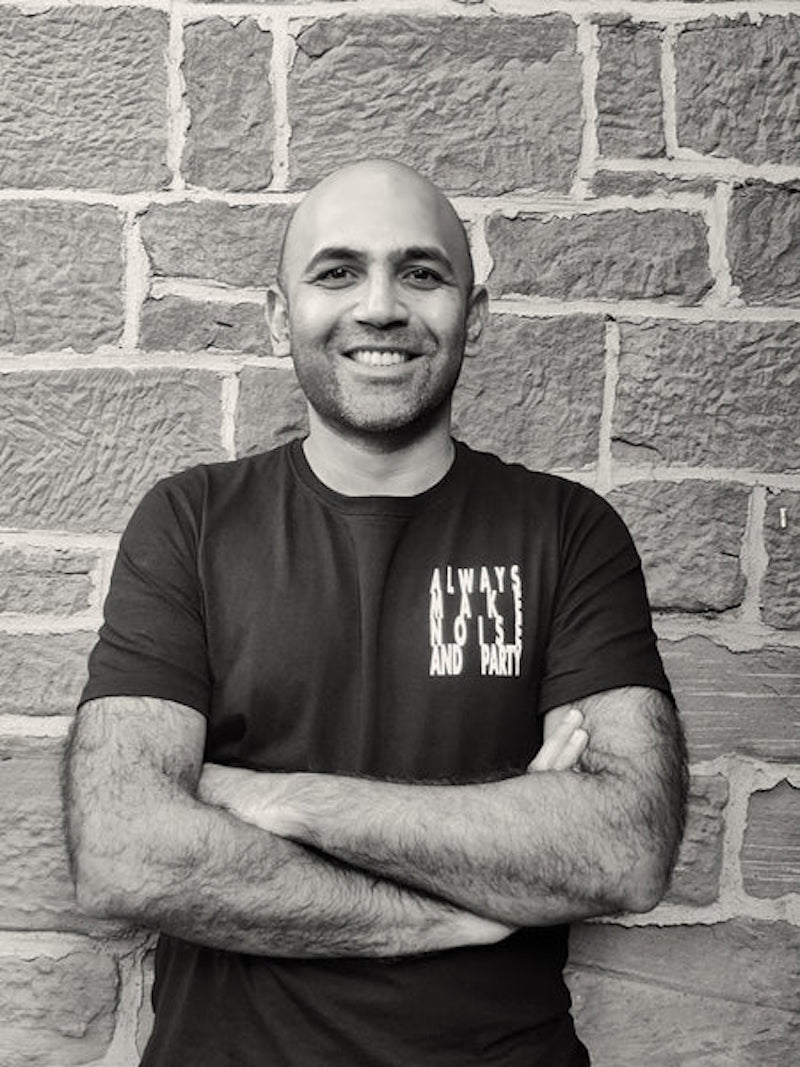 Aditya Nandwana, founder of Animal Factory
Aditya Nandwana, founder of Animal Factory
EW: There’s just so much entertainment available now, at any time of the day, no matter where you are. It’s hard to blame people for not wanting to leave their houses. It's too bad though, because your sense of community totally suffers, and you miss out on some of the unpredictable moments in life—seeing or hearing a piece of art that moves you or challenges the way you think about something. Did you ever play in bands?
AN: No, I'm a terrible musician. I was a huge Dream Theater nerd. For two years that's all I listened to. I got so anal retentive about music and I was just focusing on speed. I was having difficulties playing in time and staying in key. I had no chops. I never played in bands, though I did audition for a couple on bass. I just showed up there with my bass and a bunch of effects pedals. This friend of mine, who's a very successful commercial singer said, "Do you know how to play? Have you ever played bass in your life?" I said, "No, but I have a crazy sound," and he said, "I agree with you on that!" He said, "You're a cool guy. I'm kicking you out of the band, but let's hang out."
EW: Do you think your self-described/characterized lack of musicianship has had an effect on how you approach design for your pedals and modules?
AN: Oh, without a doubt. I’m more driven by the sound palette and texture of it all, which is something you can clearly hear in my pedal and module designs. There’s a lot of granularity and complexity, I guess. Since I don’t have musical and compositional strengths to fall back on, I have to depend on tonal variation and standing out sonically. One thing this reflects in is my tendency to keep the bandwidth very wide, treating the signal as information, so you can pick out what you want later rather than kill lows or highs prematurely. This is also important for me when I’m performing live hardware techno—I treat the distortion as an instrument itself. The Baron Samedi fuzz is a good example—it makes you play differently to get the best tones out of it. I also have never played most of the legendary vintage pedals and synths out there—so I have no frame of reference of, for example, what an MS- 20 or a Fuzz Face or a Tone Bender is supposed to sound like. Growing up with limited or no access to these things, not having a context was actually liberating—I just design things till they sound good to me.
EW: You definitely have an individual sound and aesthetic, and have done things your own way. How did that attitude inform the philosophy of the company overall?
AN: When I started building custom pedals I was a bit frustrated thinking about a brand name to build them under. I knew I didn’t want anything very generic, or anything particularly focused on guitar to be part of that name, but something more descriptive. The feeling was to combine something visceral with something incredibly cold and mechanical. I’d also been using animal themed names as placeholders for projects, such as “Flea-Ridden Cur.” At some point I was chatting with a guitarist friend who suggested that I make a low- cost transparent booster or Tube Screamer or something equally boring for the local market. I said something to the effect of: “Fuck that man. I don’t want to build shitty pedals and amps, I want to build BEASTS!”—and BAM! Two words came to my head: Animal Factory.
EW: You said at 18 you came from India to Germany to study. What were you studying?
AN: When I initially started, I was trying to get permission for a degree course for dentistry. We thought at that point that it would be good for the family business. I work with my dad, we manufacture dental plaster. It's a consistent business. It's a situation where I have to work there, because my dad's not getting any younger, and he didn't really have the foresight of succession or anything. Digital dentistry is becoming really big and I think the business in the next ten years will see a significant downturn, and that entire process of making a physical model will no longer be necessary, so it's up to me to figure out what needs to be done next.
EW: So you left India and went to study in Germany to learn dentistry?
AN: Yeah. I did a couple of years of just doing German language courses. I had done some basic German in India already, and then I enrolled in the University of Freiberg to do a semester in German language. And then from Freiberg I did three semesters in Heidelberg because you're not just supposed to know German at a conversation level. If you want to study at a university level you should be able to speak subject-specific German. The schooling was paid for by the German state, but my grades were so bad that the shot of getting into dentistry would be 1 in 50,000. The other thing is that because the state pays for education they only allow for a certain number of seats for international students. I'm guessing that the international students who got those seats really worked for it! I kind of decided in the course of that, that I didn't want to study dentistry anyway. I was a lot more attracted towards engineering disciplines. There was a new international course that was offered called "Medical Engineering," which is basically medical device design. I signed up for that. It was in this little town 60km north of Frankfurt called Giessen, and that's where I lived for four and a half years doing degree studies. I really wish I'd pursued it after that, but I didn't because I made the choice to go back and help my family with the business.
Pedals, Modular, and More
EW: Why did you start building pedals?
AN: Between moving back and just [finding] something to offset the work day, I picked up the guitar again and started building pedals. I'd done a little bit of tinkering in between, but had not really built stuff. I was always more interested in the sonic aspects of the music I listened to than playing the music. Particularly, I was enamored by distortion—the heavier and filthier, the better. One of my favorite guitar tones is [Kurt] Cobain’s on “School.” I knew straight up that I wanted to replicate that. Before I discovered schematics, I tried to distort my acoustic guitar by using a crappy headset microphone that I recorded to a primitive audio editing program called Goldwave and messed with the inbuilt effects. The results were interesting, to say the least. There were a couple of guys in bands in college who told me about guitar and how the sounds were made using these things called pedals. At some point, some kind soul told me that I could find circuit diagrams on this thing called the Internet and buy the parts at Lamington Road, our local electronics market. It sounded a LOT simpler than it turned out to be, but eventually I built Aron Nelson’s Hornet Fuzz with the help of a friend. That was the tipping point. I knew nothing about circuits or electronic components at this time, but I knew I was hooked.
EW: It’s weird when it gets you. After I built my first pedal that’s all I thought about for months. How did you transition into making Eurorack modules?
AN: Out of the blue one day I was contacted by Douglas McCarthy from Nitzer Ebb, and he told me about this event that they do in Los Angeles that he'd love to bring to India some time. That didn't happen, but I came to Berlin to meet up with [him] for a week, and it was great. I owe so much of Animal Factory to that one meeting. He took me to SchneidersLaden and he introduced me to Andreas Schneider and it was just about then that Schneider's distribution company was looking for pedal manufacturers to start working with, and six months later I started working with Alex4 [SchneidersLaden distribution company]. They checked out my stuff and really liked it, and I came to Superbooth and raised a little bit of awareness about what I do. They said, "This is good, we can work with this, but we are primarily in the modular business. Is there a way you can port these pedals to modular?"
[Above: selected modular offerings from Animal Factory—Baron Samedi, Godeater, and Pit Viper]
EW: I've heard similar stories from other manufacturers, that they started off building pedals and were persuaded by various shop owners to make modular versions. It's like the market existed before the product, which is pretty rare. Before Schneiders asked you to make Eurorack modules, were you familiar with it at all?
AN: I was familiar with the idea of modular synthesis. One of the first programs I ever started using for music was Reason. I used to make these weird self-generating patches in Reason, so I was familiar with the idea, but I'd never seen an actual modular system hands on. It was very rare to see a modular system in India.
EW: What's the modular scene like in India?
AN: Tiny. Rudimentary. [Laughter] Whenever somebody asks me how to get into modular, I say, “Are you sure you really want to? What's your budget like?”
EW: Do you have any friends that you do modular with?
AN: Sort of. There's actually a really cool three-day event that happens once a year the first weekend of February—very DIY—called Synth Farm, which is organized by a friend of mine. It happens on this little farmhouse outside Calcutta; small batches of twenty people, just geek out on synths. Hardware, software, modular, basics of synthesis...I did the DIY project the last couple of years. We got a bunch of soldering irons together last time and built these really basic Atari Punk consoles. It was a lot of fun.
EW: After Schneiders asked you to make your pedals into modules, how did you go about doing it?
AN: I started building really basic stuff. I didn't have a power supply, so I just used a bench +/- 12V power supply. I bought a 3U rack shell–one of those 19" things. At some point I bought the Dreadbox Hades kit, and assembled that. That was my testing rig.
EW: That's it?
AN: That's all the modular I had after Superbooth 1. I had pretty much nothing and used whatever I had lying around. Honestly, I didn't know where to start, and I couldn't afford [it] either. Coming from India, it's really hard to put together modular systems, it's insanely expensive. I did have an SQ-1, and that was a big help.
EW: What was the first module you made?
AN: The Pit Viper. It used the exact same board as the guitar circuit, and then it had a little sub-board, which would attenuate modular level to line level and then push it back up again to modular level.
EW: Was it hard to get parts in India?
AN: Yes. That was the problem. It was so bad. Customs can be a complete bitch in India. I had friends in the US and every now and then I would have potentiometers and capacitors [shipped to them] and they would bring them back to me. They were like, "What the fuck are you doing?" At that point I wasn't building pedals, I was building tube amplifiers. India is really strict with imports, and very expensive in terms of customs duties, which is why musical instruments in India are insanely expensive. I kind of hit a point where I said, "I can do this as a small hobby that pays for itself,” and I started ordering larger quantities of parts. That's when I needed to get a bit more organized.
EW: Is there a good outlet there to sell your pedals?
AN: Not really. There's a few of them, but I don't go to them because I know that it isn't in their interest to push something that isn't being pushed as hard as Boss or TC Electronics where they have pressure from the distributor. I don't see the point. Also, my stuff is so obscure that asking them to explain it is a bit of a tall order. And the market is really small; it's really negligible. I have better experiences when I'm selling stuff to studios and their clients come in and like my stuff.
[Above: selected pedal offerings from Animal Factory—Godeater and Pit Viper]
EW: People do love pedals. I really like the artwork you have on your stuff. Do you do that yourself?
AN: I can't do that stuff very well; I'm a terrible illustrator. I had this idea of having a different artist do every pedal, but I share an office with this fabulous visual artist named Aniruddh Mehta [@thebigfatminimalist on Instagram]. He did the new Pit Viper, Coma Reactor...he's doing everything, basically.
EW: I think it's important to have a consistent look for everything. Easily identifiable, some continuity, and maybe even a little of the collectability aspect...
AN: That's exactly what he said. I was apprehensive at the beginning, because I feel like I'm moving away from something, but if there's anything I've noticed, is that it's a good idea to let go and let people who really know their stuff do what they do best. He's been doing some work for Puma, Netflix, MixMag, The Gates Foundation. He's got this really crazy minimalist style, very geometric. I love the intricacy.
EW: That’s good that you’re able to let go a bit and have people help out. Being a one-person-show can be really trying. What’s your favorite part about doing Animal Factory?
AN: [Long pause] That's a really good question. I love the design phase a lot. I like laying out my own PCBs to some extent because I just feel more safe than if somebody does it for me. Something I've noticed is that my stuff forces people to play in different ways. With the context from where I come from, we were just following the rest of the world, where it's like, "This is how you play sweeped arpeggios,” or ”This is how you get a metal sound,” or “This is how you sound like X,Y,Z band from the states or Great Britain or something,” and I'm like, “Fuck that, this is Animal Factory!" At the end of the day it's taking that finished thing in your hand and seeing how other people interact with the thing once it's done.
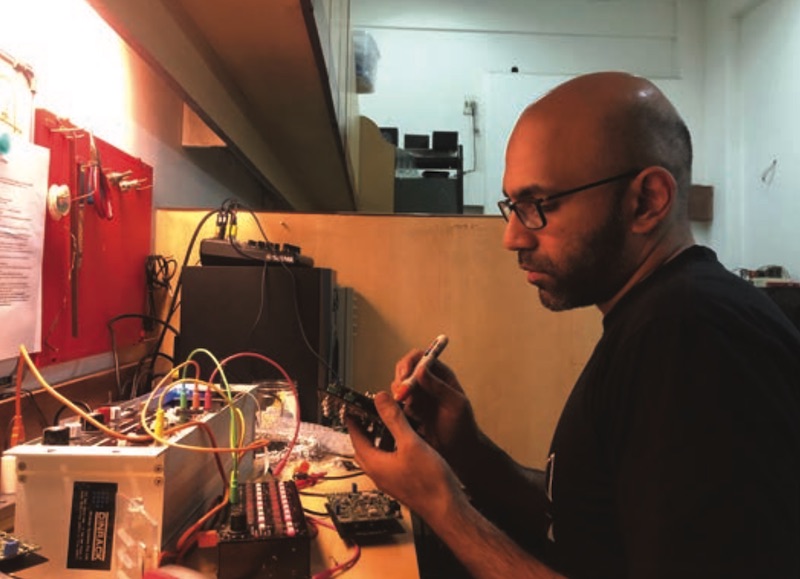 Aditya working on destroying your sound
Aditya working on destroying your sound
EW: How did you initially get the word out about Animal Factory?
AN: I met Flood [producer Mark Ellis] and he checked out my pedals. That's how I got my big boost. He really loved the Pit Viper, and he took it back to London.
EW: Where'd you meet him?
AN: In New Delhi. He was there for a conference and I said, "Holy Shit! I've got to go!"
EW: So you went and just introduced yourself?
AN: Not exactly. By that time I had known a few people in the local music scene and had been building and selling a bit, and then this friend of mine who was organizing the event said, "Your hero is here. Buy your plane ticket, get a place to sleep. You must come. You need to meet each other." Flood is the coolest guy ever. The albums that he made were instrumental for doing what I do. Broken [NIN], Depeche Mode, U2, Smashing Pumpkins...so he took the Pit Viper—and insisted that he pay for it, which is not something I'm used to—and then he texted me and said, "I just showed it to Alan Moulder, and Alan loves it!" I think I might have cried a little! Then he said, "We want four more. One for Alan, one for Ed Harcourt, one for St. Vincent, and one for Trent Reznor."
EW: Wow.
AN: I was in a state of shock for a day. That gave me a lot of credibility. Ed Harcourt wrote to say how much he loved it, and said, "It's the one pedal that never leaves my board, it's always on." St. Vincent actually went on record to say that the [Pit Viper] was her favorite pedal. Einstürzende Neubauten—one of my favorite bands of all time—they're using the Godeater bass fuzz on their new album.
EW: How did you get the Godeater in their hands?
AN: Boris Wilsdorf, the long time engineer for Neubauten, was kind enough to respond to an email I wrote on a whim when I visited Berlin in 2016 and gave me a tour of his studio [Andere Baustelle in Wedding] where a lot of the Neubauten albums were made. He also told Alexander Hacke [co-founder and bass player of Einstürzende Neubauten] about me and my pedals, which is how we ended up meeting at Superbooth in 2017. [Hacke] performed a live demo of the Godeater at Superbooth 2018, and invited me to his own studio. I’m really grateful to both of them and chuffed to know my stuff was used to record the new album.
EW: That’s really cool.
AN: I didn't think I would be doing any of this stuff; I didn’t see any of it coming. I didn't see sending pedals to Trent Reznor, or Flood, or Alan Moulder. Suddenly I'm meeting these people I'd only read about. I think you've got to be a bit of a child sometimes, to feel that amount of joy.
Thanks to Waveform Magazine
Waveform is a quarterly print magazine about sound synthesis and those who inhabit that world. Check out Waveform on our site, or head to their own website to subscribe, grab some swag, DIY projects, and more!

